Traditionalist Issues
 |
 |
 |
 |
 |
 |
 |
Renouncing the Papacy,
Benedict XVI Quotes Guardini
In his last act as Pope, while officially renouncing the Papacy and bidding farewell to the College of Cardinals in the Vatican’s Clementine Hall on February 28, 2013, Benedict XVI quoted Romano Guardini in the short speech he delivered. (1) The theologian he chose to quote in his final formal address and the excerpt itself seemed to me worthy of note, indicating the general thinking of the “retired” Pontiff.
This choice to quote Fr. Romano Guardini (1885-1968), one of his favorite theologians, should come as a surprise to no one. He has done so in almost all of his writings. Elsewhere the Pope had called Guardini "a great figure, a Christian interpreter of the world and of his own time." (2)
Guardini, a link between Modernism & Progressivism
What surprises me is how Guardini, a known modernist under suspicion of heresy before Vatican II, has been whitewashed in conservative/traditionalist circles in the United States. After the Council, Guardini found a warm reception in the Church – Paul VI even offered him a Cardinal’s hat which he refused.
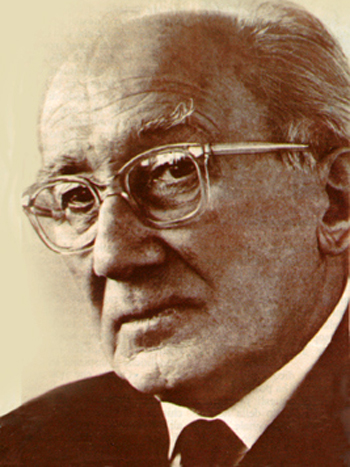 Then Sophia Press began to publish Guardini’s devotional works (The Art of Praying, Meditation before Mass, etc.) and his critiques of secondary aspects of modernity (The End of the Modern World), conveying the image of Guardini as a religious conservative. This is a major misrepresentation of the truth.
Then Sophia Press began to publish Guardini’s devotional works (The Art of Praying, Meditation before Mass, etc.) and his critiques of secondary aspects of modernity (The End of the Modern World), conveying the image of Guardini as a religious conservative. This is a major misrepresentation of the truth.
From the start, Guardini collaborated with important representatives of modern thinking such as existentialist Martin Buber, phenomenologist Martin Heidegger and personalist Max Scheler. His thinking, in turn, strongly influenced progressivists like Hans Urs von Balthasar, Giovanni Montini (Paul VI), Karl Rahner and Joseph Ratzinger. He thus became a link between Modernism and Progressivism.
Today it is generally acknowledged that Guardini played a key role in the theological and liturgical movements of the ‘30s and ‘40s that led to Vatican II. Major themes of his theology - divine revelation as God’s self-disclosure, the Church as Christian community, liturgy as ‘play’ in God’s presence, his notions of person, existence and conscience, Christian acceptance of modernity – paved the way for the adaptation of the Church to the modern world, as presented in the conciliar Constitution Gaudium et spes.
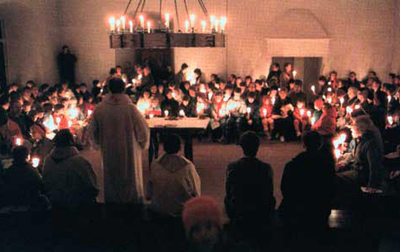 In the liturgical sphere, he was also a continuator of Modernism and a full-bodied progressivist. As early as 1927, Guardini was saying the Mass versus populum and in German in a redesigned chapel at Burg Rothenfels. Discarding the Gothic altars and elaborate décor, he stripped the church, painted the walls white and installed a moveable altar surrounded on three sides by simple stools.
In the liturgical sphere, he was also a continuator of Modernism and a full-bodied progressivist. As early as 1927, Guardini was saying the Mass versus populum and in German in a redesigned chapel at Burg Rothenfels. Discarding the Gothic altars and elaborate décor, he stripped the church, painted the walls white and installed a moveable altar surrounded on three sides by simple stools.
The focus was entirely on the congregation and the priest, together forming a community gathered for worship with no separation between them. We see that he was a worthy precursor of the Council’s Constitution Sacrosanctum Concilium and Paul VI’s liturgical reform.
It is the modernist-progressivist Romano Guardini that both Karl Rahner and Joseph Ratzinger admired and considered as their mentor. Hence, Pope Ratzinger’s last theological quote should be considered in this light.
A Church always in transformation
In the Pope’s farewell discourse at Clementine Hall, Benedict affirmed he wanted to leave the 144 cardinals present with a simple thought about the mystery of the Church. “I am helped by an expression of Romano Guardini written in the year in which the Fathers of the Second Vatican Council approved the Constitution Lumen gentium, in his last book with a personal dedication to me, so the words of this book are particularly dear to me.”
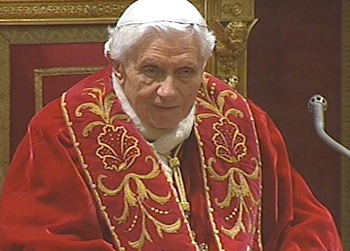 Quoting from The Church of the Lord, he continued, “Guardini said that the Church is not an institution devised and built at table, but a living reality. She lives along the course of time, evolving, like any living being, transforming herself. Yet her nature remains the same.” (3)
Quoting from The Church of the Lord, he continued, “Guardini said that the Church is not an institution devised and built at table, but a living reality. She lives along the course of time, evolving, like any living being, transforming herself. Yet her nature remains the same.” (3)
Now, while it is true that a living being is constantly transformed along the course of time, as Guardini says, a question necessarily follows: Is this transformation always good or healthful?
For example, a healthy man has a stroke and suffers paralysis on the right side of his body, speech problems and memory loss. Despite these impairments, his nature remains the same. But the accidents occasioned by the stroke have transformed his life into something completely different, worse than it was before. This change, or “reform,” in this man’s life would also be included in Guardini’s “transformation.” So the term to be discussed is “transformation.”
What did Benedict XVI mean by the Church in a constant state of transformation? In the logic of progressivist thinking, the Church would have a constant need for reform. Reform would be a basic law of her constitution, this is the concept of Ecclesia semper reformanda. (4)
From this comes the need for her to adapt her dogma, morals and her institutions to the needs of the moment. In this sense, the excerpt would both explain and justify Benedict’s decision to retire from the Papacy. He is simply adapting the institution of the Papacy to fit the needs of the time, which means to become less monarchical and more democratic in its structure.
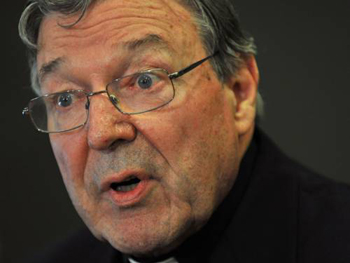 Pope Ratzinger’s radically revolutionary initiative that “transforms” the monarchical structure is a kind of stroke that strikes the Church with deleterious results to the body. Changing the accidents of the Papacy, he weakens its structure, undermining its health and leaving it susceptible to collapse.
Pope Ratzinger’s radically revolutionary initiative that “transforms” the monarchical structure is a kind of stroke that strikes the Church with deleterious results to the body. Changing the accidents of the Papacy, he weakens its structure, undermining its health and leaving it susceptible to collapse.
This destabilizing effect was actually pointed out by Card. George Pell of Australia, one of the Prelates to criticize Benedict’s resignation. On the eve of his departure from Sidney to the Vatican for the Conclave, he pointed out that Benedict was “well aware that this is a break with tradition,” adding that his resignation set a worrying precedent.
"People who, for example, might disagree with a future Pope, will mount a campaign to get him to resign," he noted. (5) That is to say, the papal office could become one like any elected office, with the Pope subject to all types of pressures, including a virtual impeachment, forced out by the people.
In such case, we must ask if Benedict’s transformation of the papal office does not ultimately seem aimed at transforming not just the accidents, but the very nature of the Papacy.
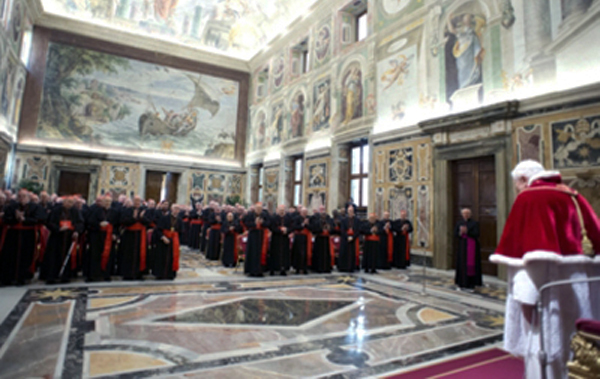

This choice to quote Fr. Romano Guardini (1885-1968), one of his favorite theologians, should come as a surprise to no one. He has done so in almost all of his writings. Elsewhere the Pope had called Guardini "a great figure, a Christian interpreter of the world and of his own time." (2)
Guardini, a link between Modernism & Progressivism
What surprises me is how Guardini, a known modernist under suspicion of heresy before Vatican II, has been whitewashed in conservative/traditionalist circles in the United States. After the Council, Guardini found a warm reception in the Church – Paul VI even offered him a Cardinal’s hat which he refused.

Fr. Romano Guardini, who paved the way for Vatican II, in secular clothing long before the Council
From the start, Guardini collaborated with important representatives of modern thinking such as existentialist Martin Buber, phenomenologist Martin Heidegger and personalist Max Scheler. His thinking, in turn, strongly influenced progressivists like Hans Urs von Balthasar, Giovanni Montini (Paul VI), Karl Rahner and Joseph Ratzinger. He thus became a link between Modernism and Progressivism.
Today it is generally acknowledged that Guardini played a key role in the theological and liturgical movements of the ‘30s and ‘40s that led to Vatican II. Major themes of his theology - divine revelation as God’s self-disclosure, the Church as Christian community, liturgy as ‘play’ in God’s presence, his notions of person, existence and conscience, Christian acceptance of modernity – paved the way for the adaptation of the Church to the modern world, as presented in the conciliar Constitution Gaudium et spes.

Guardini's chapel at Burg Rothenfels, still used today, is considered an early model of liturgical reform
The focus was entirely on the congregation and the priest, together forming a community gathered for worship with no separation between them. We see that he was a worthy precursor of the Council’s Constitution Sacrosanctum Concilium and Paul VI’s liturgical reform.
It is the modernist-progressivist Romano Guardini that both Karl Rahner and Joseph Ratzinger admired and considered as their mentor. Hence, Pope Ratzinger’s last theological quote should be considered in this light.
A Church always in transformation
In the Pope’s farewell discourse at Clementine Hall, Benedict affirmed he wanted to leave the 144 cardinals present with a simple thought about the mystery of the Church. “I am helped by an expression of Romano Guardini written in the year in which the Fathers of the Second Vatican Council approved the Constitution Lumen gentium, in his last book with a personal dedication to me, so the words of this book are particularly dear to me.”

Benedict quotes Guardini: The Church is always in a state of transformation
Now, while it is true that a living being is constantly transformed along the course of time, as Guardini says, a question necessarily follows: Is this transformation always good or healthful?
For example, a healthy man has a stroke and suffers paralysis on the right side of his body, speech problems and memory loss. Despite these impairments, his nature remains the same. But the accidents occasioned by the stroke have transformed his life into something completely different, worse than it was before. This change, or “reform,” in this man’s life would also be included in Guardini’s “transformation.” So the term to be discussed is “transformation.”
What did Benedict XVI mean by the Church in a constant state of transformation? In the logic of progressivist thinking, the Church would have a constant need for reform. Reform would be a basic law of her constitution, this is the concept of Ecclesia semper reformanda. (4)
From this comes the need for her to adapt her dogma, morals and her institutions to the needs of the moment. In this sense, the excerpt would both explain and justify Benedict’s decision to retire from the Papacy. He is simply adapting the institution of the Papacy to fit the needs of the time, which means to become less monarchical and more democratic in its structure.

Card. Pell: The Pope's resignation is destabalizing and sets a dangerous precedent
This destabilizing effect was actually pointed out by Card. George Pell of Australia, one of the Prelates to criticize Benedict’s resignation. On the eve of his departure from Sidney to the Vatican for the Conclave, he pointed out that Benedict was “well aware that this is a break with tradition,” adding that his resignation set a worrying precedent.
"People who, for example, might disagree with a future Pope, will mount a campaign to get him to resign," he noted. (5) That is to say, the papal office could become one like any elected office, with the Pope subject to all types of pressures, including a virtual impeachment, forced out by the people.
In such case, we must ask if Benedict’s transformation of the papal office does not ultimately seem aimed at transforming not just the accidents, but the very nature of the Papacy.

The Pope's last official act in Clementine Hall before the College of Cardinals on February 28, 2013
- “Pope: Farewell Discourse to College of Cardinals," The Vatican Today, February 28, 2012
- “Benedetto XVI ha un padre, Romano Guardini,” Chiesa online, October 1, 2008
- "La Chiesa si risveglia nelle anime," L'Osservatore Romano, March 1, 2012
- Atila S Guimarães,Ecclesia, Chap. IV, p.p. 193-194.
- “Pell criticizes Pope’s decision to retire,” World News Australian online, February 28, 2013

Posted March 4, 2013
______________________
______________________











